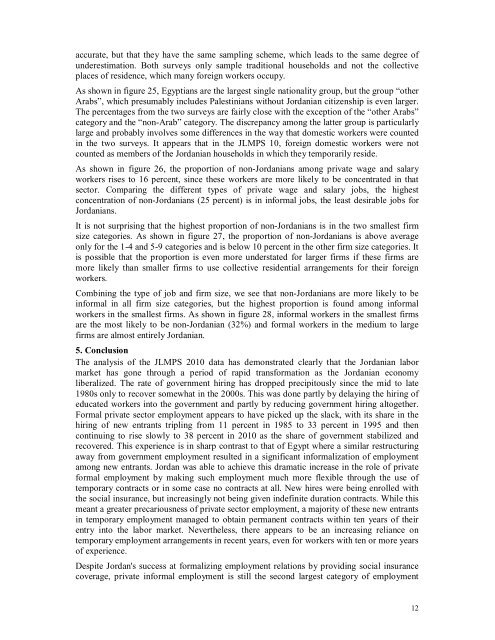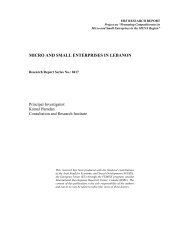The Structure and Evolution of Employment in Jordan - University of ...
The Structure and Evolution of Employment in Jordan - University of ...
The Structure and Evolution of Employment in Jordan - University of ...
You also want an ePaper? Increase the reach of your titles
YUMPU automatically turns print PDFs into web optimized ePapers that Google loves.
accurate, but that they have the same sampl<strong>in</strong>g scheme, which leads to the same degree <strong>of</strong>underestimation. Both surveys only sample traditional households <strong>and</strong> not the collectiveplaces <strong>of</strong> residence, which many foreign workers occupy.As shown <strong>in</strong> figure 25, Egyptians are the largest s<strong>in</strong>gle nationality group, but the group “otherArabs”, which presumably <strong>in</strong>cludes Palest<strong>in</strong>ians without <strong>Jordan</strong>ian citizenship is even larger.<strong>The</strong> percentages from the two surveys are fairly close with the exception <strong>of</strong> the “other Arabs”category <strong>and</strong> the “non-Arab” category. <strong>The</strong> discrepancy among the latter group is particularlylarge <strong>and</strong> probably <strong>in</strong>volves some differences <strong>in</strong> the way that domestic workers were counted<strong>in</strong> the two surveys. It appears that <strong>in</strong> the JLMPS 10, foreign domestic workers were notcounted as members <strong>of</strong> the <strong>Jordan</strong>ian households <strong>in</strong> which they temporarily reside.As shown <strong>in</strong> figure 26, the proportion <strong>of</strong> non-<strong>Jordan</strong>ians among private wage <strong>and</strong> salaryworkers rises to 16 percent, s<strong>in</strong>ce these workers are more likely to be concentrated <strong>in</strong> thatsector. Compar<strong>in</strong>g the different types <strong>of</strong> private wage <strong>and</strong> salary jobs, the highestconcentration <strong>of</strong> non-<strong>Jordan</strong>ians (25 percent) is <strong>in</strong> <strong>in</strong>formal jobs, the least desirable jobs for<strong>Jordan</strong>ians.It is not surpris<strong>in</strong>g that the highest proportion <strong>of</strong> non-<strong>Jordan</strong>ians is <strong>in</strong> the two smallest firmsize categories. As shown <strong>in</strong> figure 27, the proportion <strong>of</strong> non-<strong>Jordan</strong>ians is above averageonly for the 1-4 <strong>and</strong> 5-9 categories <strong>and</strong> is below 10 percent <strong>in</strong> the other firm size categories. Itis possible that the proportion is even more understated for larger firms if these firms aremore likely than smaller firms to use collective residential arrangements for their foreignworkers.Comb<strong>in</strong><strong>in</strong>g the type <strong>of</strong> job <strong>and</strong> firm size, we see that non-<strong>Jordan</strong>ians are more likely to be<strong>in</strong>formal <strong>in</strong> all firm size categories, but the highest proportion is found among <strong>in</strong>formalworkers <strong>in</strong> the smallest firms. As shown <strong>in</strong> figure 28, <strong>in</strong>formal workers <strong>in</strong> the smallest firmsare the most likely to be non-<strong>Jordan</strong>ian (32%) <strong>and</strong> formal workers <strong>in</strong> the medium to largefirms are almost entirely <strong>Jordan</strong>ian.5. Conclusion<strong>The</strong> analysis <strong>of</strong> the JLMPS 2010 data has demonstrated clearly that the <strong>Jordan</strong>ian labormarket has gone through a period <strong>of</strong> rapid transformation as the <strong>Jordan</strong>ian economyliberalized. <strong>The</strong> rate <strong>of</strong> government hir<strong>in</strong>g has dropped precipitously s<strong>in</strong>ce the mid to late1980s only to recover somewhat <strong>in</strong> the 2000s. This was done partly by delay<strong>in</strong>g the hir<strong>in</strong>g <strong>of</strong>educated workers <strong>in</strong>to the government <strong>and</strong> partly by reduc<strong>in</strong>g government hir<strong>in</strong>g altogether.Formal private sector employment appears to have picked up the slack, with its share <strong>in</strong> thehir<strong>in</strong>g <strong>of</strong> new entrants tripl<strong>in</strong>g from 11 percent <strong>in</strong> 1985 to 33 percent <strong>in</strong> 1995 <strong>and</strong> thencont<strong>in</strong>u<strong>in</strong>g to rise slowly to 38 percent <strong>in</strong> 2010 as the share <strong>of</strong> government stabilized <strong>and</strong>recovered. This experience is <strong>in</strong> sharp contrast to that <strong>of</strong> Egypt where a similar restructur<strong>in</strong>gaway from government employment resulted <strong>in</strong> a significant <strong>in</strong>formalization <strong>of</strong> employmentamong new entrants. <strong>Jordan</strong> was able to achieve this dramatic <strong>in</strong>crease <strong>in</strong> the role <strong>of</strong> privateformal employment by mak<strong>in</strong>g such employment much more flexible through the use <strong>of</strong>temporary contracts or <strong>in</strong> some case no contracts at all. New hires were be<strong>in</strong>g enrolled withthe social <strong>in</strong>surance, but <strong>in</strong>creas<strong>in</strong>gly not be<strong>in</strong>g given <strong>in</strong>def<strong>in</strong>ite duration contracts. While thismeant a greater precariousness <strong>of</strong> private sector employment, a majority <strong>of</strong> these new entrants<strong>in</strong> temporary employment managed to obta<strong>in</strong> permanent contracts with<strong>in</strong> ten years <strong>of</strong> theirentry <strong>in</strong>to the labor market. Nevertheless, there appears to be an <strong>in</strong>creas<strong>in</strong>g reliance ontemporary employment arrangements <strong>in</strong> recent years, even for workers with ten or more years<strong>of</strong> experience.Despite <strong>Jordan</strong>'s success at formaliz<strong>in</strong>g employment relations by provid<strong>in</strong>g social <strong>in</strong>surancecoverage, private <strong>in</strong>formal employment is still the second largest category <strong>of</strong> employment12

















